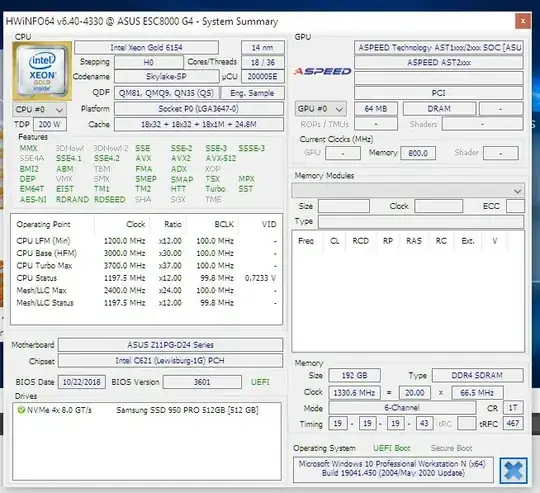I am testing a GPU Compute Server (ASUS ESC8000 G4) with 2 Intel Xeon Gold 6154 CPUs and I ran the newest version of the Intel Diagnostic Tool (IPDT, Version 4.1.4.36.W.MP) and the tool passes all tests and indicates that both are Genuine Intel CPUs. But CPU-Z and HWInfo show the CPUs are Engineering Samples ("ES"). What is going on? Should I rely on Intel's Diagnostic Tool or doubt the CPUs to be genuine production-grade products? All hardware diagnostic tools I tried (HWInfo, CPU-Z, IPDT, Task Manager show that all cores run at full spec capacity and I have not had any issues so far) but the CPU-Z and HWInfo page still makes me doubt...any ideas what is going on? I also noticed that the newest version of the Intel IPDT tool does not include the SPBC tool, could that be the reason? Where can I get the SPBC tool?
Asked
Active
Viewed 168 times
1
-
Pop the heatsinks off and look at them. – Michael Hampton Dec 21 '20 at 22:26
-
@MichaelHampton, I edited my post and included a photo of the CPU itself – Matt Dec 21 '20 at 23:01
-
1That looks like a production CPU rather than an engineering sample. An ES version would be stamped QMQ9 and INTEL CONFIDENTIAL. CPU-Z and HWInfo are probably out of date. – Michael Hampton Dec 21 '20 at 23:24
-
@MichaelHampton, ok, thanks for sharing your opinion. Though, technically I do not see a huge challenge to etch (with or without laser) something onto the CPU surface. But it would be much harder, technically, to alter a digital signature in the microcode. Hence my confusion why the Intel-own tool outputs a different result than other hardware profilers. – Matt Dec 22 '20 at 04:14
-
1I would trust Intel's opinion about a CPU before a third party! – Michael Hampton Dec 22 '20 at 20:08


